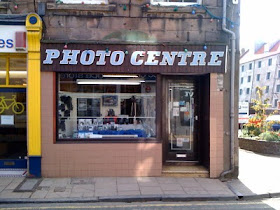At the weekend I braved the gales and fine mist of sea-rain to head to the borders, spending Saturday afternoon in Berwick-on-Tweed. As well as possessing some fine old fortifications, it also possesses some of the oldest-looking shop signs and frontages in the Kingdom. By 'old' I don't mean Victorian pawn-brokers balls and the sort of antique carpentry you see in that James Mason exploitumentary about London, I mean 'old' as in seventies plastic lettering, timber-fronts and coloured glass. The sort of thing you saw on every high street about twenty years ago but rarely do now. Here is a very fine camera shop illustrating my point:

Everything about the shop is modern apart from the sign. Why? I don't know actually. Berwick town centre has a homogeneity about its architecture, with lots of imposing, steep-fronted stone buildings and very little sixties / seventies Arndale-type intrusion. Across the road from the Three Barrels pub (recommended) there is this venerable institution:


It was still up and running when I last visited two months ago but seems to have closed for good now. It was unheated, and run by two old gentlemen wearing various scarves and layers of damp tweed. Stock consisted of a few sweets, cigarettes and a few pots of cockles. Unheated, dark and fitted out with wonderful old wall-to-wall shelving, it wasn't like a time warp, more like a scene entirely out of time. The owners also ran a newsagent across the road, which was even more spartan than their main shop. This too has closed;



Check out the waffle-type wall cladding, where the shopkeeper could attach hooks and hang things at whim. I would love to know what all that parapehanlia on the shelves at the back is; old account books? Unsold copies of The Eagle? I never went into the newsagents while it was open for business, but was able to get that last glimpse of the past through the window. A visit to Berwick-on-Tweed for its old shop fronts (including a spectacularly eighties cafe) is highly recommended.


























